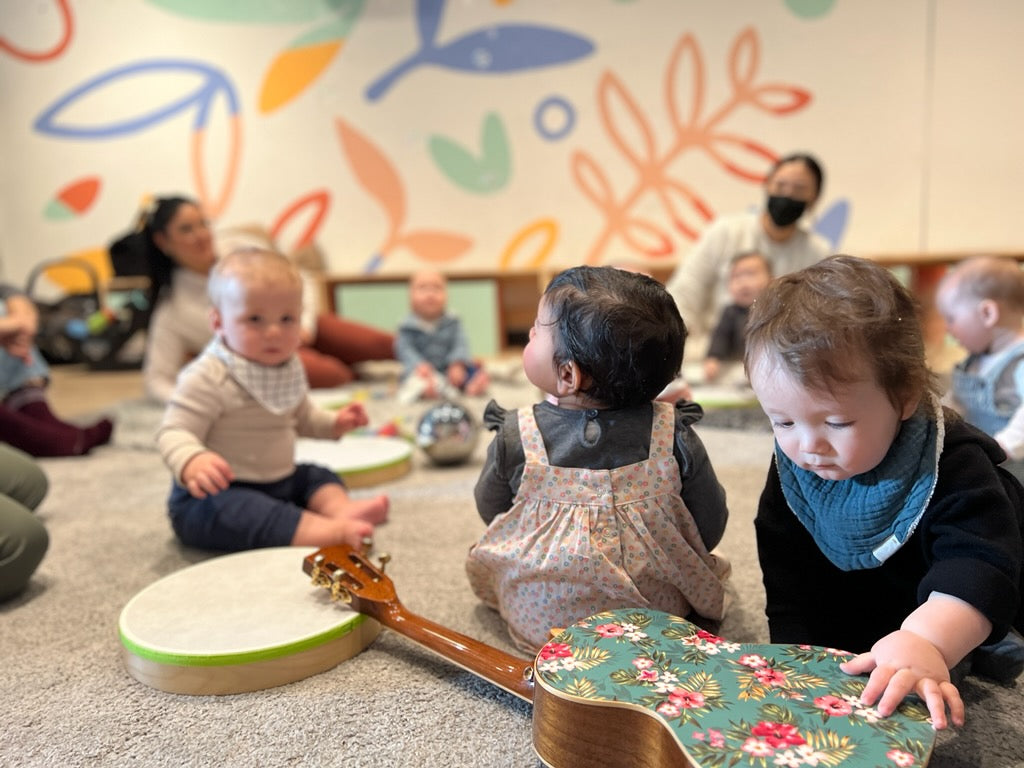Play in the Early Years with Shauna Farrell

Learning and play are indistinguishable in the early years. All play is learning and play is the most effective form of learning. When we look at a child's play from this perspective we can trust the child to initiate their own learning. In the words of Magda Gerber, our caregiver's role in learning is to create an environment that is physically safe, cognitively challenging and emotionally nurturing.
In order to encourage exploration we want to make sure the environment is as safe as necessary so we don't need to interfere with a child's exploration by saying "no" or "be careful". This doesn't necessarily mean eliminate all risks, but rather making sure the risks available are appropriate to the child's capabilities and our comfort level. For example, we want to make sure a toddler will not be able to climb a bookshelf that might tip over on them, but may invite them with a pile of cushions on the floor that are wobbly where they might roll off as they climb.
Is it developmentally and cognitively appropriate? How do we know? When we offer a play invitation we can sit back and observe how the child interacts with it. If they show no interest it may be to developmentally advanced for them. If they play for a moment and then move on it is probably not cognitively challenging enough. When they can explore and discover with focus it is just right. It is important to allow the child some time to discover on their own without adult interference. The child is then allowed to choose what they will learn and how without us dictating what they should do with a play material. This child-led time will also let us discover what type of play interests the child at this stage of development.
At first, child's play can be a mystery as they do the same thing over and over, sometimes showing little interest in anything else - lining up toy cars or animals in a long row or dropping food of the highchair tray dozens of times. However, there is systematic learning at play here...
Play Schemas
A play schema is a repeated behaviour or set of behaviours within an organized framework. There are 9 types of play schemas:
Connection (also Disconnection): joining things together and taking them apart, opening and closing things. This schema teaches fine motor skills, spatial awareness Examples: containers with lids, taping things together, building with blocks (and knocking them down) lego
Enclosure: containing things, exploring the borders of things. This schema teaches object permanence, planning, predicting Examples: forts, boxes, moats around sandcastles, lining up food around the plate
Enveloping: covering themselves or objects, hiding things. This schema teaches object permanence, fine moto skills, problem solving Examples: peekaboo, painting their whole hand, wrapping an object in a scarf
Orientation: observing from different viewpoints. This schema works on strengthening the sensory/vestibular systems Examples: hanging upside down off the couch, looking through their legs upside down, looking through binoculars, tunnels, swings
Rotation: interest in spinning and turning. This schema teaches gross and fine motor skills, how things move Examples: balls, wheels on cars, rolling pins and playdough, rolling clay into balls, spinning themselves
Positioning: arranging objects in a particular way. This schema teaches pre-math and science classification Examples: lining up toy cars, sorting objects by colour, size, etc., loose parts play
Trajectory: throwing, dropping or rolling. This schema teaches cause and effect, visual tracking and prediction Examples: dropping food to the floor, rolling cars down a ramp and through tubes, throwing balls
Transforming: mixing, combining and transforming. This schema teaches fine motor skills, prediction Examples: mixing paint colours, mud and water, cooking
Transporting: carrying themselves and objects from one place to another. This schema teaches proprioception (awareness of ones body orientation in space), planning and measuring Examples: carrying rocks in your pockets, putting objects into shopping bags, water in pipettes from one container to another.
Schemas will be expressed in different ways at different stages of development. A young toddler may enjoying knocking down stacks of blocks, a preschooler may make elaborate structures with magnatiles.
Often you will see a combination of play schema, especially in older toddlers and preschoolers. For example, a pretend store may involve both positioning and transporting.
Memorizing the different schema is not so important, but realizing that there ARE different schema is. What is being learned in each schema and the examples given are not a complete list by any means, but they will help you have an understanding of what your child is focused on at any given time when you are observing them play. Recognizing what type of play they are engaged in can help you plan and provide more interesting learning opportunities. You can help the child satisfy the urge to practice and learn within safe and acceptable limits. For example a child working within the trajectory schema who is provided with plenty of opportunities to throw rolled up socks into a basket and send cars down a ramp may feel less need to throw other toys or drop food of their highchair.
When we observe our children's play and allow them to lead their exploration and discoveries we are giving them the opportunity to foster their own learning at exactly the right time and stage for them. In turn, this experience will give them the intrinsic motivation and confidence to be lifelong learners.
Contributed by Shauna Farrell
